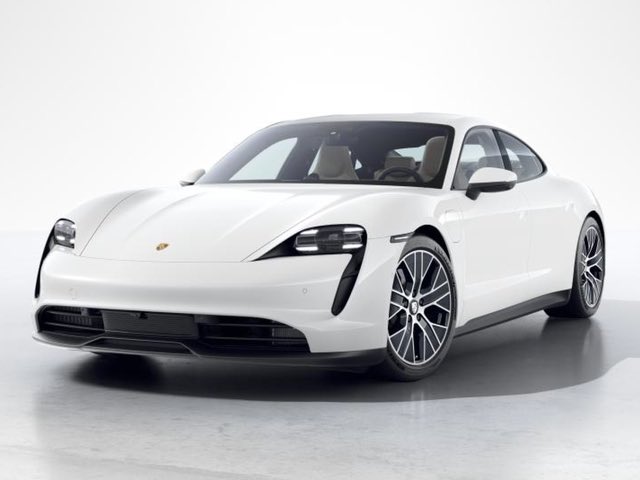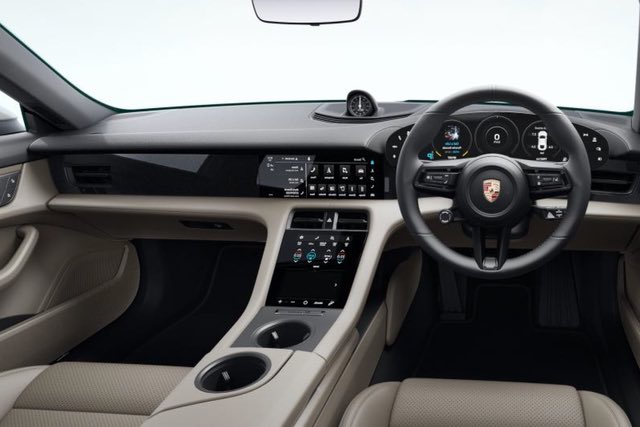Porsche Taycan

The new Porsche Taycan is Porsche's first all-electric vehicle. Four versions are currently available – the rear-wheel drive Taycan, then the all-wheel drive Taycan 4S, Turbo and Turbo S.
Driving It
As standard, the base Porsche Taycan offers 240kW (321bhp) of power. In its temporary over-boost mode, power leaps to a Jaguar I-Pace-sized 300kW (402bhp), and that’ll punt you from 0-100kph in a claimed 5.4 seconds. Spend more on the Performance Battery Plus (just under £5k), and battery capacity climbs from 79kWh to 93kWh, upping claimed range from 354 km to 407 km. Meanwhile you get 375bhp under your right foot, or a temporary 469bhp on over-boost – though Porsche says the upgraded car isn’t any quicker, because the battery weighs more.
At the other end of the price list, the Turbo S makes an astonishing 616bhp in normal mode (750bhp in over-boost). 0-100kph takes 2.8 seconds and it’ll do a 10.8 second quarter-mile. Carbon-ceramic brakes and wider tyres are standard, as is a range of between 390 km. Yes, you’ll want the Turbo S more than any of the other Taycans, but in 99 per cent of road-based situations the Taycan and 4S, with the big-battery option, are all you need.
Locate the toggle selector behind the wheel, flick into D and the car hums gently, just enough to let you know it’s alive. Around town the Taycan is effortless, silent, comfortable and doesn’t feel as wide as it looks – a joy, in other words, even when the traffic and speed cameras conspire against you.
The steering is spot on, not massively detailed in its feedback, but not overly caffeinated either and with a sense that your hands have a direct connection to the front wheels. Body roll is all but absent at sane speeds, remarkable given how supple the air suspension is in everything but Sport+ mode, even on 21s. You can of course sense the weight - the momentum that needs shedding or shifting direction, the way the suspension hits its stops on big compressions - but both the low centre of gravity (lower than a 911) and drop-kick acceleration the nanosecond you need it do a great job of masking the worst. It feels heavy, but not 2.3 tonnes.
Part of that credit goes to the brakes. Mostly, when you apply them what your leg feels is synthesised, pads don’t meet discs until you really stomp on the pedal. The regen system can feed a massive 265kW back into the battery, so only calls on mechanical friction when you exceed that. Programming even a semi-natural feel must have been a headache and a half, but they’ve done it. In fact, Porsche reckons 90 per cent of the time all your braking will be by regen and you’ll be blissfully unaware – which is why the standard cast-iron brake discs on the Turbo have a tungsten-carbide coating – to stop them rusting from neglect.
Pouring it down a B-road, I’ll admit, I miss pulling paddles. It’s part of finding your rhythm down a fast road: two yanks and a bit of brake, turn-in, feed the throttle back in, change up, change up, repeat. Without it you find yourself arriving at bends faster than you think and, assuming you’re not half way up a tree by this point, slamming the throttle earlier than you’d normally dare. Traction is mightily impressive, even in the RWD car, but overall there’s less for the driver to do.

What is it like on the inside?
The driving position is as near as to a 911, but the environment is all-new. The centre console locks you in but floats leaving space beneath and the only physical buttons are on the wheel and doors. In here, the screen is king – a sculptural, curved one behind the wheel, a standard rectangular 10.9-inch one in the middle of the dash, an I-Pace style portrait one where your left hand rests, and an utterly pointless (but fortunately optional) one above the glovebox in front of the passenger. The same passenger who is perfectly capable of moving their hand three inches to the left and using the central screen to mess with your music or plug something into the sat-nav.
Next to a Model S, the gimmick count is low, but that passenger screen is unnecessary, as are the directional air vents controlled deep in a sub menu on the main screen. What’s wrong with manually pointing the vanes? But there’s familiarity, too. Your driving modes – Range, Normal, Sport and Sport+ - are controlled via a dial on the steering wheel, and although all the interfaces and graphics are unique to the Taycan, anyone that’s driven a Porsche will be at ease within the hour. As you’d expect, quality is spot-on.
The boot is as big as a Golf’s (366-litres) and there’s a small frunk too (81-litres), and while you can squeeze a six-footer in the back, the rear seats are more suited to kids or vertically challenged motoring journalists. Porsche has, however thoughtfully carved a space for your feet into the battery under the floor – something they call the ‘foot garage’.


Summary
What separates the Porsche Taycan from what’s gone before is its 800V architecture – double the norm. Higher voltage means lower current; lower current means less heat in the batteries, motors and electronics, repeatable performance, faster charging and a thinner, lighter wiring loom that can snake around other components more easily for tighter packaging. Circles don’t get more virtuous. It was an expensive decision, says Porsche, but once every other manufacturer cottons on, prices for 800V components should tumble.
Clearly this is not a cheap car, However the perks are many: the ability to charge at home for a fraction of the cost of a tank of petrol and peace of mind that you’re not polluting the immediate air around you.
If all these interest you and you wish to get hold of one, do hit us up.
Porsche Taycan Electric
| MAX POWER | 240 kW |
| MAX TORQUE | 345 Nm |
| 0-100KM/H | 5.4 seconds |
| TOP SPEED | 260km/h |
| VES BAND | A1 |
| ELECTRIC RANGE | 433 km |
| CONSUMPTION | 20.3 kWh/100km |
| BATTERY CAPACITY | 79.2 kWh |